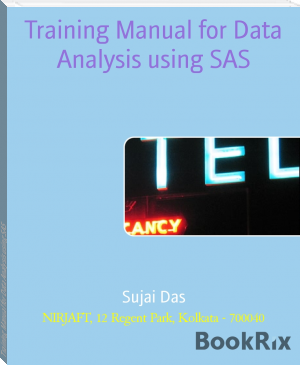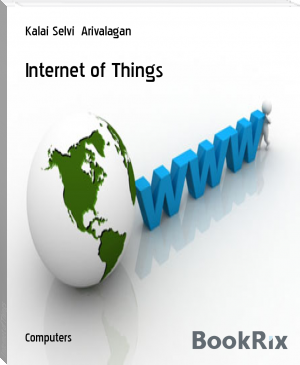Cloud Computing Tools, Kalai Selvi Arivalagan [10 ebook reader TXT] 📗

- Author: Kalai Selvi Arivalagan
Book online «Cloud Computing Tools, Kalai Selvi Arivalagan [10 ebook reader TXT] 📗». Author Kalai Selvi Arivalagan
Cloud computing is the use of various services, such as software development platforms, servers, storage and software, over the internet, often referred to as the "cloud."
In general, there are three cloud computing characteristics that are common among all cloud-computing vendors:
The back-end of the application (especially hardware) is completely managed by a cloud vendor.
A user only pays for services used (memory, processing time and bandwidth, etc.).
Services are scalable
Many cloud computing advancements are closely related to virtualization. The ability to pay on demand and scale quickly is largely a result of cloud computing vendors being able to pool resources that may be divided among multiple clients.
It is common to categorize cloud computing services as Infrastructure as a Service (IaaS), Platform as a Service (PaaS) or Software as a Service (SaaS).
Recent times, there has been discussions regarding the use of cloud-based office productivity tools in a modern office set up. Most of the organisations imply that web-based office solutions cannot be a replacement for desktop tools. The desktop tools have become a part of routine work procedure at desk. Major concern arises only if there is any problem in running or non-availability of tools.
The three common cloud computing tools for businesses available through hosted services using Internet are:
Software-as-a-Service (SaaS): This cloud computing tool with its low cost services helps organisations to access software from servers using web browsers. SaaS applications are available with procuring a subscription from the service provider. The application not only reduces the cost of buying a licensed software, it also reduces the need for technical staff to manage and upgrade software. Some of the SaaS providers for business are Salesforce, Google Apps, and Dropbox.
Platform-as-a-Service (PaaS): This cloud computing tool can help organisations by providing the platform to develop and run their own application. PaaS applications provide users a virtual environment where the service providers take care of the network infrastructure, server hardware, server software and the operating system. Some of the PaaS providers are Google App Engine, Heroku, and OpenShift from Red Hat.
Infrastructure-as-a-Service (IaaS): Utilising this tool, users can build a virtual data centre in the cloud. Users can access directly their storage, servers, and operating systems as they would access the traditional servers at their office. The service provider hosts, maintains, and controls the cloud infrastructure. The tool is available as pay on a per-use basis. IaaS is more of a data center replacement. Some of the IaaS providers are Amazon Web Services, Microsoft Azure, Rackspace, Vmware, and Citrix.
Community Cloud
A community cloud is a cloud service model that provides a cloud computing solution to a limited number of individuals or organizations that is governed, managed and secured commonly by all the participating organizations or a third party managed service provider.
Cloud computing offers flexibility and efficiency at every stage in big data analytics – from accessing, analysing and delivering results. With a well defined data classification policy, it can be used wherever data privacy and security are the main concern.
Big data consists of both structured (transactional information, invoices, sales data) and unstructured data (emails, documents, video, images) generated by computers and the other connected devices. Streams of data are generated every day in an organisation, from business applications to data from various sensors and tracking devices. To process high volumes of data within a short period, big data requires a cluster of servers that comprise a huge amount of computing resources.
Every business today strives to find ways to gather, process and analyse perceptions from the different kinds of collected data. Organisations expect to derive valid perceptions from the collected data so that they can arrive at the most intelligent decision. Big data offers persistent efforts to arrive at a competitive solution that will benefit the organisation.
Normally, processing large data sets, which comprise both internal and external data, involve huge amount of computing power, expensive software licenses, manpower costs. Due to huge investment to procure anlaysis by big data, it can be out of reach for many organisations. But, the cloud computing tool can help organisations to achieve results in a cost effective manner.
Some of the familiar cloud service providers for big data and analytics services are: Amazon Web Services, RackSpace, Microsoft Azure, and Google. Microsoft Azure offers products that can analyse huge amount of data in real time and provide the ability to know how to increase revenue, to improve customer management and to maintain lower costs.
Azure HDInsight handles any amount of data on demand. The data can be from terabytes to pentabytes and it gives the freedom to the customer to spin up any number of nodes at any time. It can process even semi-structured or unstructured data from devices, sensors, server logs, web clickstreams and social media. Analysing newly generated data, the user can explore and tap the relevant potential for new business opportunities.
Infrastructure
Infrastructure as a Service (IaaS) provider is one of the three main cloud computing models. This model provides virtual server space, bandwidth, network connection, and IP addresses for organisations to adopt a dynamic infrastructure. It also makes their business future-ready and have prominent customers.
IaaS cloud solution eliminates delays in utilising resources. The services can be utilised whenever needed, and they have to pay only for the used resources. With the Internet connection, they can access resources from any location.
To protect their data from getting lost, small or large organisations follow disaster recovery plans that suit their business models. If an organisation has branches in different locations that follows different disaster recovery plans, it turns to be time consuming and expensive. IaaS offers a consolidated disaster recovery infrastructure that reduces cost and handles difficult situations. The IaaS cloud computing prompts quick recovery with no loss of data. Organisations can access data through this cloud computing platform and function as usual with email, web servers and browsers.
Organisations need not worry about the physical security of centres where data is stored. There is no single point of failure. Even if one server fails, the service will not get interrupted. Multitude of hardware resources and configurations support the system to run successfully.
The IaaS model offers lower infrastructure costs. Organisations need not maintain hardware or network equipment or replace any old equipment. This pay-as-you-go model has significant cost savings. As IaaS use is metered, organisations have to pay only for the capacity needed at any given time. This avoids monthly or annual fees for features they are not using. The IaaS model demands no upfront charges, bandwidth utilisation fees or minimum term commitments.
Some of the familiar IaaS cloud solution providers are: Amazon AWS, Windows Azure, Google Compute Engine, Rackspace Open Cloud, IBM SmartCloud Enterprise, HP Enterprise Converged Infrastructure.
ImprintPublication Date: 03-06-2017
All Rights Reserved
Dedication:
Cloud Computing Tools





Comments (0)